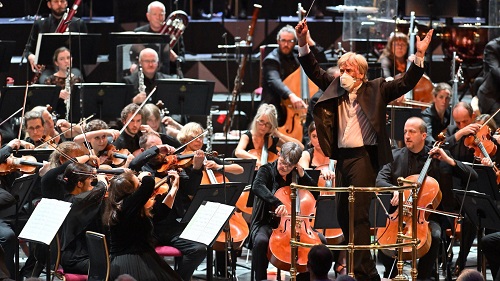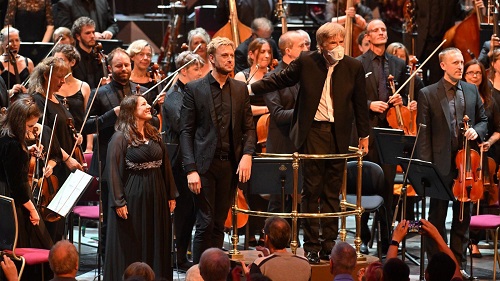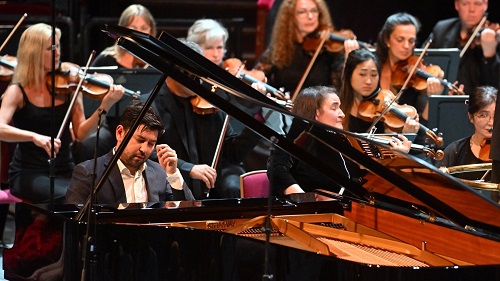“I think many people are in for pleasant surprises as they get to know Nielsen: his rough charm, his swing, his drive, his rhythmic surprises, his strange power of harmonic and tonal relationships – and especially his constant unpredictability – all these are irresistible. I feel confident that Nielsen’s time has come.” The words of Leonard Bernstein when conducting The Royal Danish Orchestra in a performance of the Danish composer’s Third Symphony (‘Sinfonia espansiva’) in Copenhagen in 1965, as part of a centennial celebration of Nielsen’s birth.
Well, in the almost six decades since Lenny’s endorsement, audiences have got to know Nielsen much better, but the jury is perhaps still out on whether Nielsen was a daring symphonic experimenter and modernist or a competent but not very original composer of works in the late-Romantic style of, but not equal to, Brahms. In his programme article, Daniel M. Grimley remarks that 1911, the year in which the Third Symphony was composed, was also the year of Mahler’s incomplete Tenth, Elgar’s Second and Sibelius’s Fourth, the latter perhaps seeming ‘a vivid testament to the symphony’s final gasp as a genre’. Grimley might also have noted that 1911 was also the year of the premiere of Stravinsky’s The Rite of Spring. But, if that work might have seemed to have foregrounded rhythm at the expense of melody and modulatory harmony, then perhaps we can see Nielsen as asserting a musical counter-argument that there innovation and development of those traditional elements was still possible, his fresh interplay of keys and his dynamic structures declaring that there was life in the symphony yet.

In what is his last season as Chief Conductor of the BBC Scottish Symphony Orchestra, conductor Thomas Dausgaard has been making the case for his fellow Dane in a spring series presenting a cycle of Nielsen’s symphonies (though the launch concert in January which featured the Third Symphony was conducted by Geoffrey Paterson, after Dausgaard withdrew citing continuing health risks and travel difficulties arising from the pandemic). After several concerts in Scotland the BBC SSO and their Chief Conductor have arrived in London for two Proms concerts each of which pairs a Nielsen symphony with a Beethoven piano concerto.
The titles which Nielsen appended to some of his symphonies indicate a general mood rather than a ‘programme’ and, in a letter to the publisher C.F. Kahnt & Sons in 1913, the composer took pains to emphasise that ‘my Sinfonia espansiva is of course conceived as absolute music’, explaining later that such titles – ‘The Inextinguishable’, ‘The Four Temperaments’, for the Fifth and Second Symphonies respectively – were a way of describing ‘the only thing that music in the end can express: resting forces in contrast to active ones’. There were certainly active forces at the start of the Allegro espansiva in this Proms performance as Dausgaard scarcely paused to acknowledge the applause before hurling the BBC SSO into the explosive, accelerating unison blows which open the first movement of the Third Symphony.
Playing with a blazing spirit, and led by a characteristically vigorous Laura Samuel, the musicians cleanly negotiated the tricky rhythms despite the propulsive tempo, but if there was fire in Dausgaard’s belly, he didn’t let the flames fan out of control. Rich, expressive colours enhanced the ecstatic mood, including gleaming violins – the players deftly getting their fingers around Nielsen’s challenging climbs and surges – and dark brass, the four trombones and tuba adding a lovely weight to counter the racing wind and strings. And, as the movement progressed there was spaciousness enough for the finer points of detail to be heard. The ‘cooling down’ (a finely shaped diminuendo from timpanist Gordon Rigby) into the second subject was perfectly judged, and here the lines opened up, show-casing characterful, varied textures, excellent woodwind playing and tight ensemble among the strings. When the waltz resumed it was with a breezy charm and bounding stride. The joyful sweep of the movement was brilliant, the brass punchy but elegant, the whole shining with élan.
Nielsen described his pastoral Andante as depicting, “peace and calm in nature, interrupted only by the voices of a few birds, or what you will”, and the sustained horn pedals at the opening certainly established an unruffled mood, perfectly tuned and never wavering, against which the unison strings’ melody gently undulated. Elegantly phrased woodwind counterpoint etched the birdsong pristinely, the expansiveness of the landscape suggested by the distance between the arabesques and the low timpani and double bass pedal, while the sumptuousness of the strings’ theme and the care with which it was phrased were impressive. Dausgaard conjured an increasing urgency as the various sections conversed.

Commenting on the end of the movement, Nielsen suggested that ‘the rural calm and depth grows rather more concentrated (E-flat major) and from afar off one hears human voices; first a man’s and later a woman’s voice, which once more disappear, and the movement ends in entirely unemotional calm (trance).” In fact, his manuscript score shows that originally the second movement was purely instrumental, but the composer later added two vocal parts with words underlain, “All thoughts vanished. I lie beneath the sky.”, subsequently omitting the text. The voices of baritone Benjamin Appl and soprano Elizabeth Watts certainly came ‘from afar’, their floating contours drifting from the heights of the Royal Albert Hall gallery. Both singers sustained good intonation, despite Nielsen’s tricky writing – Watt’s top Bbs were perfectly placed and gleaming in tone – and the singers’ distanced placement. Dausgaard wove instruments and voices together beautifully, creating a magical, dreamy poetry.
The Allegretto woke everyone up again, though, the woodwind chattering impishly, wriggling violins thumbing their noses at the assertive celli and bassoons, horns chipping in with stabbing interjections. Dausgaard captured the mischief of the movement but also the shadows that lurk beneath the laughter. Of the final movement Nielsen wrote: “The main subject is used much and the character of the movement is maintained with as much zest and energy as possible.” The BBC SSO duly flew and soared, with an Elgarian nobility when required, surging towards the return of the opening hymn which was thrilling and celebratory. Conducting the entire programme from memory, Dausgaard truly realised the vivid drama of the music, communicating his lucid vision of the work with a clarity that was a joy to see, showing real empathy with the players and clearly inspiring them.

The concert had opened with Ravel’s ‘choreographic poem’, La valse. The opening sonorities were suitably murky, the oscillating double basses, quietly throbbing pedal, rumbles and fragments sounding less like a homage to Vienna and more a macabre dance of death. But, Dausgaard gradually let the brightness peep through – the glimmer of a chandelier, the flash of whirling silk, harp glissandi sparkling, the sheen of the violins glossy. Tempos, arching this way and that, were as flexible and teasing as an ironically raised eyebrow. Occasionally, Dausgaard let the melodies slip into a more simple grace and eloquence, but the menace was never entirely banished – the paradox perfectly sustained.
The soloist in Beethoven’s First Piano Concerto was the Uzbek pianist, Behzod Abduraimov, who held the Hall’s attention from the very first note. He has a superlative technique – the first movement especially is spilling with virtuosic runs, arpeggios and grace notes – but he allies this with both intelligent musicianship and a ‘star-quality’ flair which here made what is sometimes referred to as a ‘backward-looking’ concerto seem fresh and bold, but never bombastic. Abduraimov’s performance was a model of clarity and effortless dexterity, and Dausgaard was, as always, a sympathetic accompanist, ears and eyes constantly alert to his soloist’s choices. Particularly lovely was the directness of tone and expressive voice-leading in the Largo. The encore was ‘Mercutio’ from Prokofiev’s Romeo and Juliet Op.75. I’m sure that Shakespeare’s fun-lover would have been delighted that Prokofiev’s musical wit wrong-footed the Prommers into clapping too soon.
Thomas Dausgaard’s final performance as Chief Conductor of the BBC SSO takes place tonight (18th August), in a programme comprising Sibelius’ Seventh Symphony, Beethoven’s Fourth Piano Concerto (with pianist Francesco Piemontesi) and Nielsen’s Fourth Symphony, ‘The Inextinguishable’. Both these BBC SSO concerts, and all of the season’s performances are available free on BBC Sounds for one year.
Claire Seymour
Prom 41: Behzod Abduraimov (piano), Elizabeth Watts (soprano), Benjamin Appl (baritone), BBC Scottish Symphony Orchestra, Thomas Dausgaard (conductor)
Ravel – La valse, Beethoven – Piano Concerto No.1 in C major Op.15, Nielsen – Symphony No.3 Op.27, ‘Sinfonia espansiva’
Royal Albert Hall, London; Wednesday 17th August 2022.